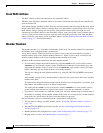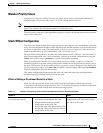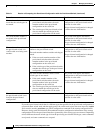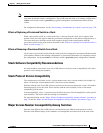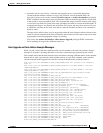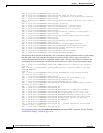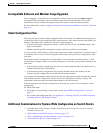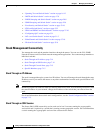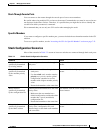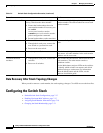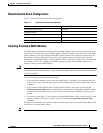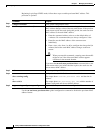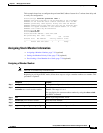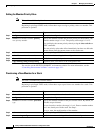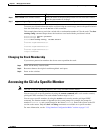
7-14
Catalyst 2960 and 2960-S Switch Software Configuration Guide
OL-8603-09
Chapter 7 Managing Switch Stacks
Understanding Stacks
• “Spanning Tree and Switch Stacks” section on page 16-12
• “MSTP and Switch Stacks” section on page 17-9
• “DHCP Snooping and Switch Stacks” section on page 20-8
• “IGMP Snooping and Switch Stacks” section on page 22-6
• “Port Security and Switch Stacks” section on page 23-18
• “CDP and Switch Stacks” section on page 25-2
• “SPAN and RSPAN and Switch Stacks” section on page 27-10
• “Configuring QoS” section on page 33-1
• “ACLs and Switch Stacks” section on page 31-5
• “EtherChannel and Switch Stacks” section on page 37-10
• “IPv6 and Switch Stacks” section on page 35-6
Stack Management Connectivity
You manage the stack and the member interfaces through the master. You can use the CLI, SNMP,
Network Assistant, and CiscoWorks network management applications. You cannot manage members as
individual switches.
• Stack Through an IP Address, page 7-14
• Stack Through an SSH Session, page 7-14
• Stack Through Console Ports, page 7-15
• Specific Members, page 7-15
Stack Through an IP Address
The stack is managed through a system-level IP address. You can still manage the stack through the same
IP address even if you remove the master or any other stack member from the stack, provided there is IP
connectivity.
Note Members keep their IP addresses when you remove them from a stack. To avoid having two devices with
the same IP address in your network, change the IP address of the switch that you removed from the
stack.
For related information about switch stack configurations, see the “Stack Configuration Files” section
on page 7-13.
Stack Through an SSH Session
The Secure Shell (SSH) connectivity to the stack can be lost if a master running the cryptographic
version fails and is replaced by a switch that is running a noncryptographic version. We recommend that
a switch running the cryptographic version of the software be the master.



